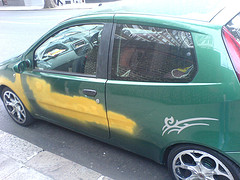
flickr.com/richardsummers
A vehicle with an excellent paint job is one of life’s true joys. It’s like being the kid with the biggest piece of birthday cake or with the best bike in the neighbourhood. Whether you drive a a ’66 Beetle, a ’47 Eldorado, or an ’07 for two, a fantastic paint job will take your vehicle from ho-hum to headturner.
Actually creating a magnificent automotive paint job takes finesse and skill. Automotive painting is one of the most painstaking and arduous tasks in crafting an automobile. It can also be one of the most pricey. If you are on a financial plan, there are options for you. Some paint shops can provide a good paint job for a fair price. Your other choice is to take on the task yourself. If the paint job is a success, you’ll have even more to be proud about: a hot set of wheels AND a “do it yourself” tale to tell.
Achieving a great paint job is a step-by-step procedure. You just can’t rush automotive painting. Follow the primary steps of preparation, primer application, blocking, final paint coat and detail application. This can seem like a daunting task for any beginner, but the entire work can be completed in just a few days.
Prepare
Before you start, check with local bylaws and regulations regarding the use of spray paint in homes and enclosed areas. The last thing you require is a legal holdup delaying your painting job.
Cleaning the vehicle is your next crucial step. The vehicle must be spotlessly clean and free of dirt. Use detergents to wash the car top to bottom, and then follow up with grease removers. After the car has been cleaned, it’s time to start sanding. An air sander (preferably a dual-action sander) should be used to eliminate the old paint from the car. This kind of sander will not cause body damage because it removes paint without digging like other grinders and sanders. Every trace of paint must be removed to create an ideal palette for your new paint job. Automotive detailing tape or even duct tape can be used to cover and protect other parts of the car, including windows and plastic moldings. In addition to removing the old paint, all bits of rust have to be sanded off. Rust will spread if untreated or ignored , and the last thing you want is body rot happening under your spiffy new paint. You can fix minor body flaws on the car’s surface using fillers. Shape the compound with precision using a sanding board, then follow up with a glazing compound. This method will help to ensure a smooth-as-glass finish on your ride.
Mask
After the whole vehicle has been initially washed, then sanded, a final cleaning takes place and the vehicle is ready to be masked. In this process, every part of the car that shouldn’t be touched by paint is protected and covered. Bear in mind, you will be using high-grade automotive paint that doesn’t wash off with water. Cover your windows, every light and reflector, wheels, door handles, all window rubbers, all chrome tires, wipers.. take a good look and what needs to be masked. If you don’t want even the smallest bit of over spray on it, cover it up! The materials and tools needed for masking are available at automotive supply warehouses and hardware stores.
Prime
Priming is an important step to providing a good foundation for your new paint. A flawless prime coat will help you to realize a perfect paint job. Valspar epoxy is a good primer choice, combining reliable filling capabilities with minimal shrinking. After the primer has been applied, a second coat in a contrasting shade should be applied on top of the first layer. This will act as a sanding guide. The primer should be sanded to a smooth finish, but don’t sand too powerfully or you could actually damage the body of the car. When the priming is full, a sealer is applied and a final sanding takes place.
Finishing off
In finishing off the automotive painting, it is imperative to achieve uniform colour. The spray gun should be held ten to twelve inches away from the body to prevent streaks and runs. This is needed when applying the basecoat, final coat and clear coat.
Regardless of the type of vehicle you drive, a new paint job can turn it into a real showstopper. Automotive painting can be a time consuming job, but you can do it if you take it step by step. The creative energy will be good for your soul, and the greetings you receive will be great for your confidence.
Tagged with: car maintenance • car painting
Filed under: Car Maintenance